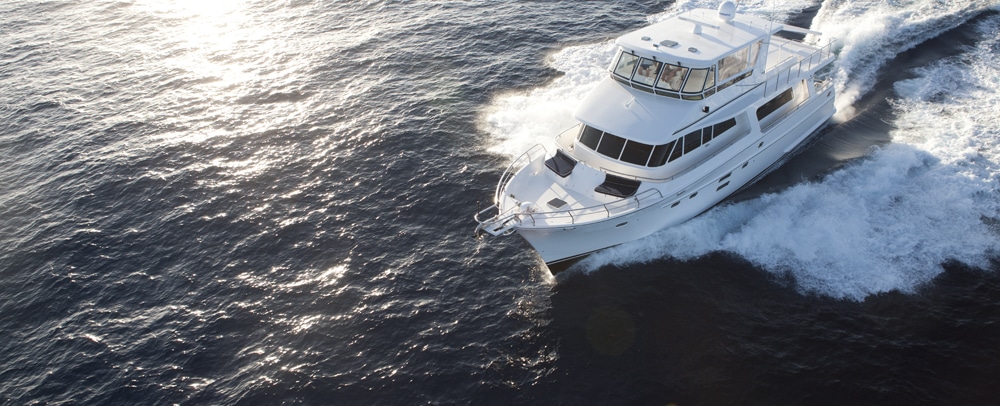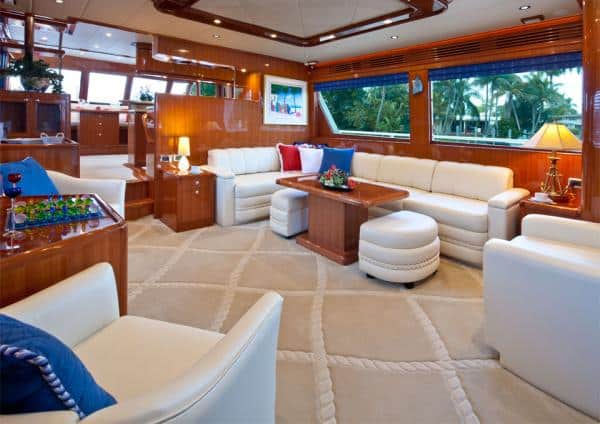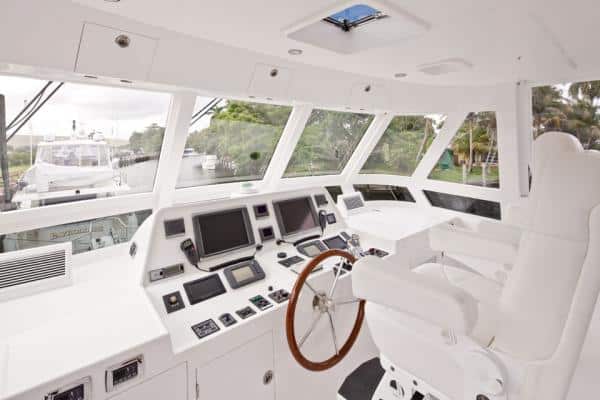
Hampton Endurance 680 LRC Main
Hold this thought by celebrated basketball coach John Wooden: “It’s the little details that are vital. Little things make big things happen.“
By the time I caught up with the new Hampton Endurance 680 Long Range Cruiser, she was already on a tight schedule. If you’re considering a boat designed and built to do some serious cruising, then it’s completely understandable that you don’t want to sit at the dock. And if her owner is like many of the other Hampton owners I’ve interviewed over the years, I suspect this boat’s time at the dock will be quite limited.
I felt the pressure while trying to shoehorn my way on board for my sea trial. The latest offering in the Endurance lineup had already made an appearance at the Fort Lauderdale International Boat Show. Then she went through the detailing and cleanup from all the foot traffic, a pre-show aerial photo shoot, then an interior shoot and the final sea trial for the twin 873-horsepower Caterpillar C18 diesels. Now her owner was chomping at the bit to get his hands on the wheel of his new boat and head over the horizon to the Bahamas.
When I finally managed to get on board, along with Anchor Yacht’s Forest Roberts, who heads up the Lauderdale-based Hampton dealership, Coach Wooden’s words kept going through my head: “Little things make big things happen.“
Some of the Hampton’s little things are actually big. The bottom, from the keel to six inches above the waterline, is a solid fiberglass laminate. The Kevlar-reinforced collision zone extends from the bow area 12 feet aft under water and then out to port and starboard another 12 feet. Among the truly little things I noticed is the way the legs of the stools at the portside island galley were secured. The two front legs fit neatly and securely into a cutout at the base of the counter, anchoring them to the island.
“They’ll never slide or tip over while she’s under way or in a sea. Simple solution,” Roberts said. Slick.
This small touch was just the first of multiple details I discovered on the 680. A unique latch on the door of the full-size refrigerator keeps the door closed in a pitching sea. There were screens on the easy-to-swing pantograph doors. I took particular note of the electrically operated and custom-fit designer blinds on the usual out-of-reach forward windows, which will effortlessly cut harsh sunlight. I found drains on the bridge deck seamlessly connected to overfills to prevent water from pooling topside. And the engine room air intakes were located on the inboard sides of the exterior’s wide walkways, in order to significantly discourage salty mist from making its way into the machinery.
Based on countless boat tests, I’ve found this attention to detail almost always signifies that the big items will also stand out. And they certainly did on this Endurance.
_View a complete photo gallery here._

It’s easy to extol Hampton’s craftsmanship on the 680’s interior, what with the perfectly matching African makore cherry and flawless, high-gloss finish. The accommodations layout includes comfortable and fully finished crew quarters aft — an area that could easily double as a private space for the children or grandchildren of owner/operators. Our test model featured four staterooms and four heads, with sufficient stowage, perfect for extended cruising. Several optional layouts are available.
Topside, the spacious enclosed bridge, with dining and seating area, has almost 20 feet of open space extending from the back of the house, while the main-deck cockpit has its own alfresco table and seating. In addition, there is a useful and well-placed day-head on the afterdeck. Put that all together with her Portuguese bridge and a salty profile, and this boat is ready to go.
However, it was in her Soundown-insulated and air-conditioned engine room that I could truly appreciate the builder’s attention to detail and safety.
“Redundancy is one of the keys to our building philosophy,” Roberts said. “We want and need our owners to feel and be safe while under way.”
To that end, I found a hands-on-owner’s dream space, with room to work on any part of the mains, gensets, pumps, or any other critical maintenance or service area, and the kind of backup systems that create an indisputable safety factor.
For instance, there are two saltwater air-conditioning systems with two AC circulation pumps. There are a pair of freshwater Headhunter pumps, one 110-volt and a backup 24-volt DC unit. Two power steering pumps and a pair of heavy-duty pumps from the power-takeoff on the transmissions can drive the Wesmar nine-square-foot fins, as well as both 33-horsepower bow and stern thrusters. The automatic oil-change system services the mains, the 23 and 15 kW Kohler gensets and both transmissions. There are eight 115-amp AGM marine batteries in boxes for the house system, a pair of 200-amp, boxed AGM starting batteries per engine and a 100-amp heavy-duty battery, also boxed, for each genset. Then there are a pair of shore-power isolation transformers with ISO boost, two 75-foot Glendinning Cablemasters and a 4 kW inverter. Combine that with sturdy, no-nonsense construction and the Endurance 680 more than lives up to her name.
With owner Ted Lange at the wheel, we headed out the inlet for our sea trial.
“One important thing for me was to drive the boat head on into a sea of some size, just like those four-footers out there, and avoid the pounding we experienced on many of our other boats,” Lange said.
To his delight the boat proved very responsive and there was no pounding. With the stabilizers activated, she was comfortable even when we placed the boat beam to the swells. In following and quartering seas, the 680 also responded very well. “The rudders are large enough to steer the boat without any difficulty,” he said. “I was pleased with the first sea trial and at no time experienced any negative attributes.”
Lange and his wife are veteran boaters. “We’ve had everything from 51-footers up to a 151,” said Lange, beaming a new-owner smile as we toured the engine room.
“At this stage in our lives, being in our mid-70s, we wanted a boat we could handle by ourselves. We liked all we had heard and read about Hampton and decided to have a closer look. The size, interior arrangement and equipment were just what we were looking for. We were very impressed.” In fact, the Langes are spending this winter aboard in the Bahamas.

Lange also mentioned the input Roberts had with the factory. “Forest has had input on some suggested improvements with the factory in China, and I think it has taken most of those, as they certainly show up in the operation of the boat.”
Her performance numbers reveal another positive attribute: range. At 8.4 knots the 680 sipped fuel at a miserly eight gallons per hour. With a 2,000-gallon fuel capacity, this equates to a range of approximately 2,100 miles. “On the performance side, the 680 is all there,” Roberts said. “You can get the kind of economy and range you want from her as well as being able to get up and go should the weather or conditions warrant it.” Indeed, we reached a top speed of 19.2 knots, and the twin Cats gave her a high cruise of 14 knots.
If you put together all the little things aboard Hampton’s Endurance 680 LRC, the result is one well-built, well-designed yacht with the right layout, appropriate balance between power and efficiency, luxurious accommodations and cruising abilities to get the job done in style.
_View a complete photo gallery here._
Test Conditions: Speeds were measured by GPS off Fort Lauderdale, Florida, in three- to four-foot seas with 10 to 15 knots of wind, full fuel and water and six people on board. Fuel consumption was calculated by the electronic engine-monitoring system.
RPM Knots GPH
800 4.0 4
1000 8.4 8
1200 10.6 14
1400 11.7 22
1600 12.3 38
1800 14.0 52
2000 16.0 64
2100 17.1 82
2200 19.2 90
LOA: 68’0″
LWL: 64’8″
BEAM: 18’8″
DRAFT: 5’2″
DISPL.: 110,000 lb.
WATER: 400 gal.
FUEL: 2,000 gal.
DEADRISE: 9 degrees
ENGINES TESTED: 2 x 873 hp Caterpillar C18 diesels
BASE PRICE: $2,989,800
PRICE AS TESTED: $3,010,889
Hampton Yachts, 949-673-6300; www.hamptonyacht.com









